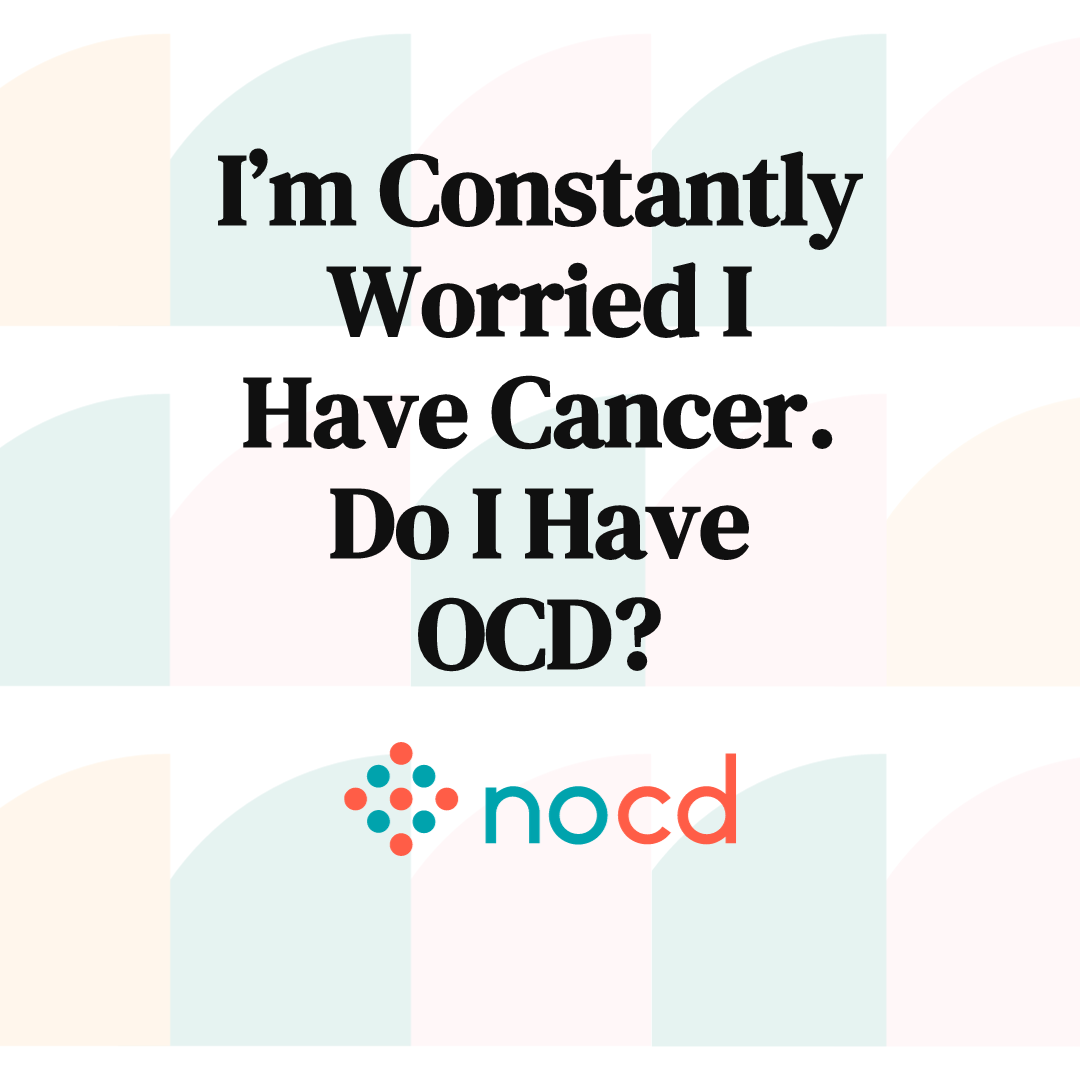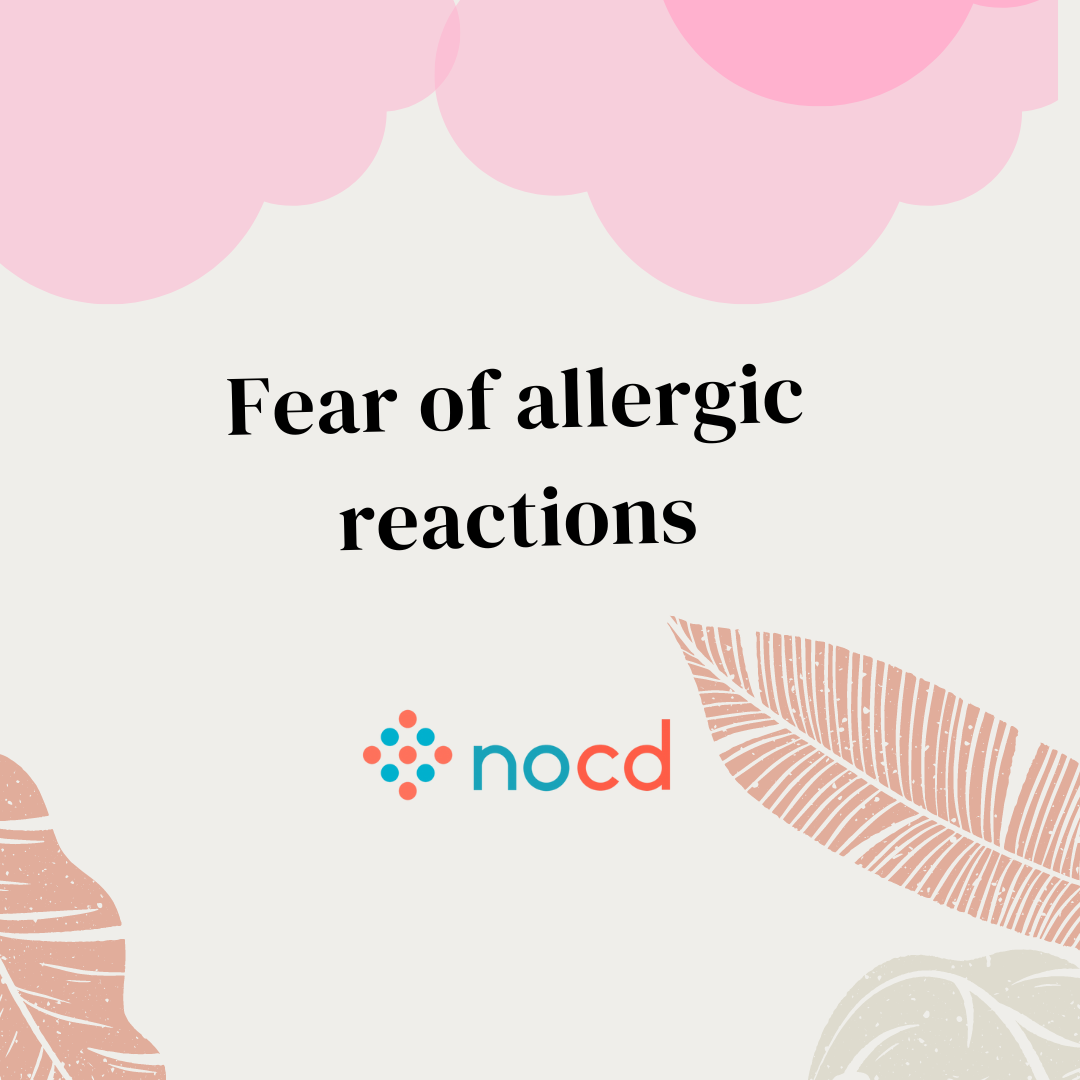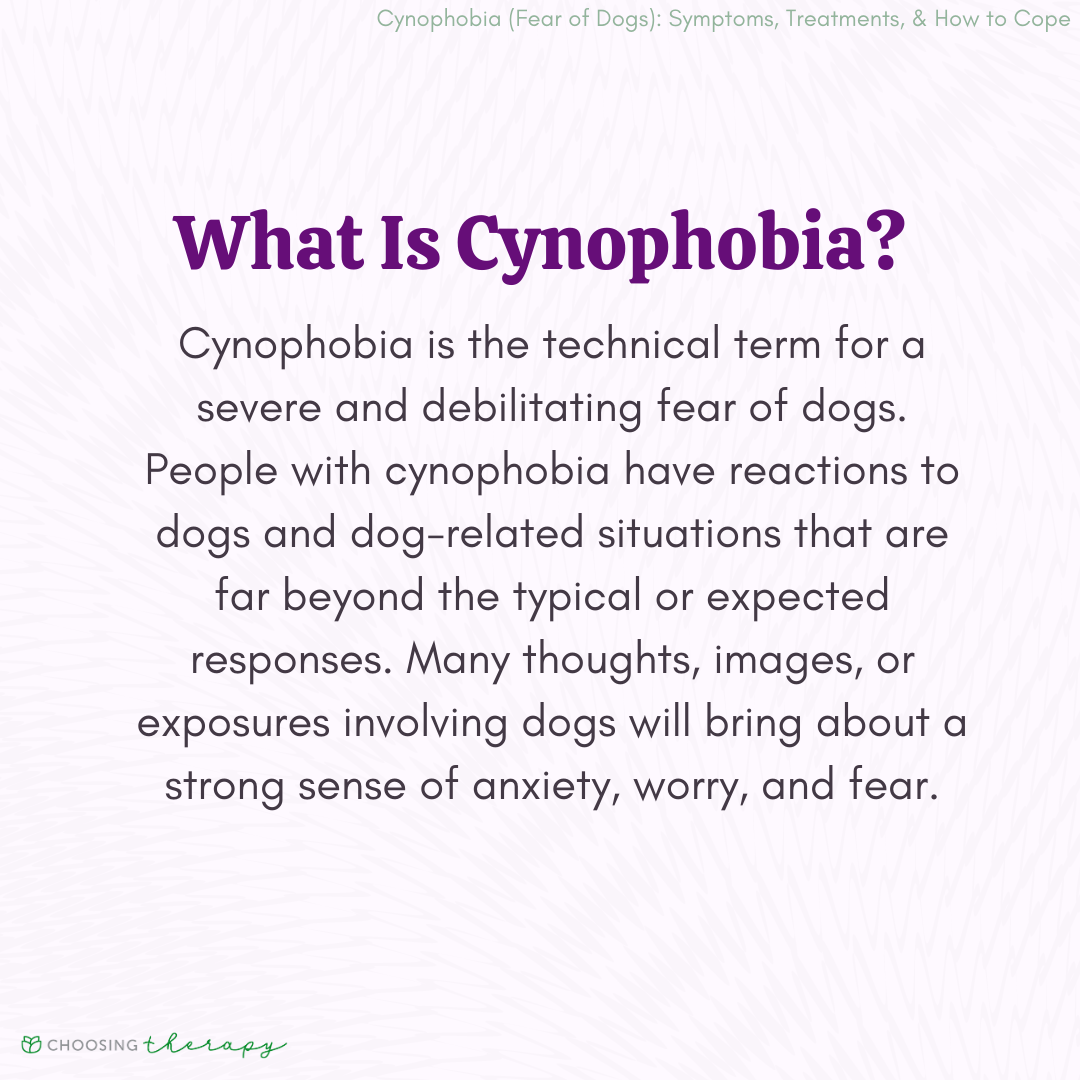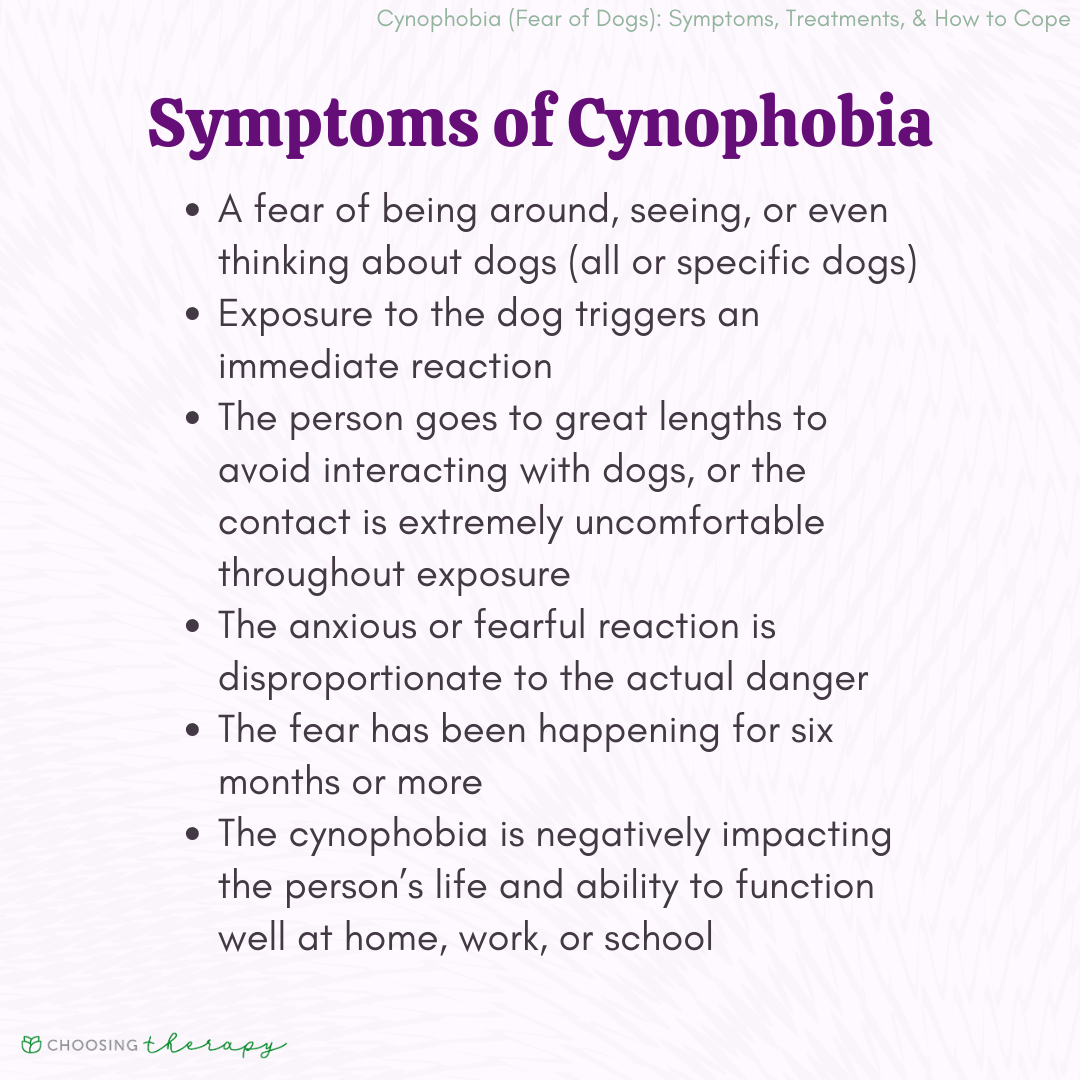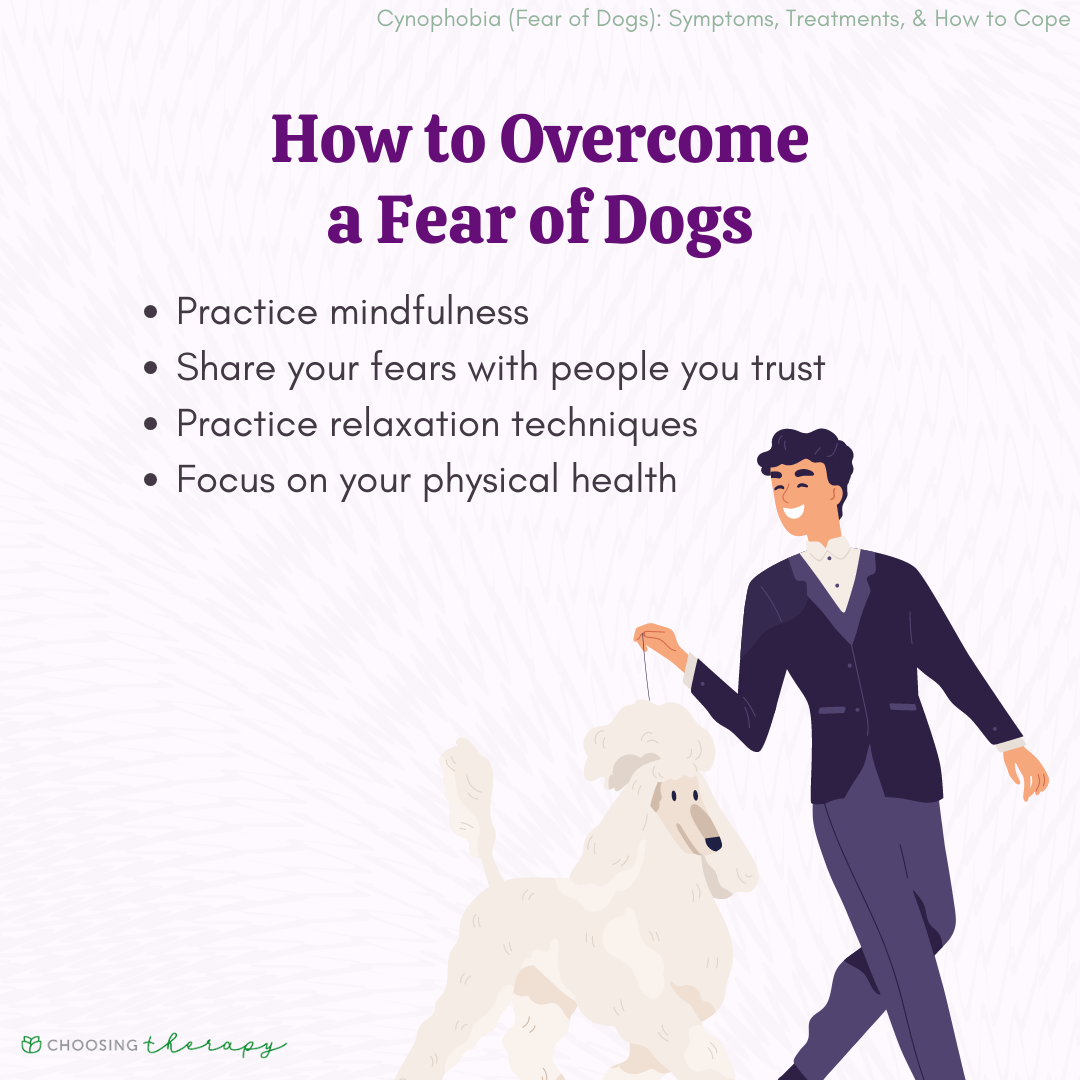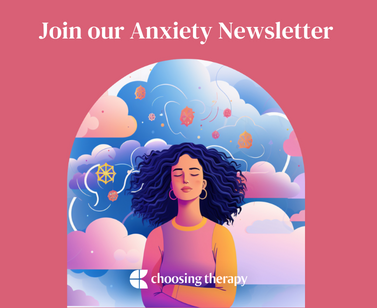Cynophobia is an extreme, intense, irrational fear of dogs that can drastically impact a person’s life, routines, and well-being, making normal life a challenge. Due to its intensity and influence, the condition stands in contrast to simply being fearful or shy around dogs. With treatment options focusing on therapy, people with cynophobia can lower symptoms quickly.
Would you like to have less fear and anxiety? Therapy can help. BetterHelp has over 20,000 licensed therapists who provide convenient and affordable online therapy. BetterHelp starts at $65 per week. Take a Free Online Assessment and get matched with the right therapist for you.
What Is Cynophobia?
Cynophobia is the technical term for a severe and debilitating fear of dogs. People with cynophobia have reactions to dogs and dog-related situations that are far beyond the typical or expected responses. Many thoughts, images, or exposures involving dogs will bring about a strong sense of anxiety, worry, and fear.1
As a type of anxiety disorder, cynophobia is not a natural or healthy response to dogs. The condition is an irrational and persistent fear that arises in situations where it is not necessary or adaptive. Cynophobia can cause someone to panic just from a playful dog walking past or an extreme worry about the possibility of encountering a dog after leaving the house.
Cynophobia Vs. a Normal Response to a Scary Dog
Alternatively, if a person feels scared and anxious when confronted by a barking, growling, or an aggressive dog, they do not necessarily have cynophobia. They could be experiencing a typical and protective reaction to a perceived threat.1
How Common Is Cynophobia?
An intense fear of dogs is a fairly common phobia for people in the U.S., and about one third of all animal phobias involve dogs.7 As many as 13% of older people in the U.S. have cynophobia.8
Symptoms of Cynophobia
The most prevalent symptom associated with the fear of dogs is the uncontrollable sense of anxiety, stress, worry, and fear when faced with the animal. All specific phobias have a set list of symptoms that mental health professionals use to diagnose and treat anxiety disorders; however, not everyone who fears dogs will have a diagnosable dog phobia.
Symptoms of cynophobia include:1
- A fear of being around, seeing, or even thinking about dogs: sometimes, the fear will involve all dogs, and other times the fear may be more limited to a specific breed, size, or trait.
- Exposure to the dog triggers an immediate reaction.
- The person goes to great lengths to avoid interacting with dogs, or the contact is extremely uncomfortable throughout exposure. It does not seem to improve with time.
- The anxious or fearful reaction is disproportionate to the actual danger. A tiny dog should not create a sense that the person’s life is being threatened.
- The fear has been happening for six months or more.
- The cynophobia is negatively impacting the person’s life and ability to function well at home, work, or school.
Outward Signs of a Dog Phobia
In addition to the symptoms experienced by the individual, friends or loved ones could notice certain signs of dog phobia. People with cynophobia may feel shame or embarrassment linked to their fear of dogs, so they will not offer much information about the subject. In those situations, loved ones must be vigilant in looking for the signs of dog phobia.
A person with cynophobia may display these signs:2,3,4
- Finds excuses to avoid places or situations where dogs will be present
- Frequently discusses their dislike of dogs
- Appears jumpy, keyed up, sweaty, or shaky when dogs are around
- Attempts to talk people out of getting a dog as a pet
- Ends relationships with people who have dogs
As many as 75% of people with one specific phobia actually have another diagnosable fear. So a person with cynophobia could have one or more additional fears.1
Fear of Dogs in Kids
Children will often express fear and discomfort stemming from new people, places, and situations, but many children also express anxiety, reluctance, and concern around dogs. Children and teens between the ages of 13 – 17 have the highest rates of specific phobia with many cases developing before age 10.1 The challenge comes in separating a typical and healthy fear of something new from a significant mental health disorder.
Symptoms and signs of cynophobia in children are:1,3
- Crying
- Having a temper tantrum
- Freezing and being unable to move or follow parental requests
- Clinging to parents or other adults and being unable to separate
Not every child who appears frightened, uncomfortable, or tearful around dogs will have cynophobia, though. Only professionals can provide the diagnosis after notable symptoms persist for six months or longer.
Options For Anxiety Treatment Talk Therapy – Get help from a licensed therapist. Betterhelp offers online therapy starting at $65 per week. Free Assessment Psychiatry for Anxiety – Looking for anxiety treatment that prioritizes you? Talkiatry can help. Find an in-network psychiatrist you can see online. Get started with our short assessment. Visit Talkiatry
What Causes a Phobia of Dogs to Develop?
Causes of cynophobia and other specific phobias aren’t widely understood. Like other mental health conditions, a person’s genetics, brain functioning, and environment seem to play a major factor.3
Here are three possible causes of cynophobia:
- Genetic link: This is probable since many people with specific phobias seem to have anxious parents. This connection could also illustrate the power of the environment as parents unwittingly teach their children to fear dogs due to their own stress.
- Brain functioning: Someone at risk for cynophobia could have an exaggerated response in brain chemistry. The release of neurotransmitters and hormones could spark an overly intense physical reaction that creates more fear and anxiety.2
- Negative experience with a dog (especially at an early age): If someone was bitten, attacked, or even jumped on by a dog, the event could be enough to trigger a phobia. Without positive experiences to counter the negative, the fear of dogs is left to grow.
Impacts of Living With a Dog Phobia
Someone with a dog phobia will note a marked departure from typical functioning whereas someone who is merely uncomfortable or fearful around dogs won’t see their life change or shift from the norm.4 The person with cynophobia will avoid people, places, and events associated with dogs.
Symptoms may start slow and small, such as missing a few days at work or losing a few friends with dogs. Over time, the impacts could become more widespread. Eventually, a person with cynophobia may only feel comfortable in the most familiar settings like home or the home of a close loved one. Going into the community presents too much of a risk of seeing a dog.
Specific phobia can also result in complications like:4
- Substance abuse as a form of self-medication
- Depression
- Thoughts of suicide
- Increased risk of suicide attempts
- Social withdrawal or isolation
How to Overcome a Fear of Dogs
Depending on the severity, duration, and root of cynophobia, a person may greatly improve their functioning with a few subtle changes, such as practicing mindfulness, speaking openly about their fears, working on relaxation techniques, and adding more exercise to their routine.
Here are some tips for dealing with a dog phobia:3
- Practice mindfulness: Mindfulness involves being more attentive and attuned to one’s own thoughts, feelings, and behaviors. By being mindful, a person can learn how to manage anxiety and limit their pattern of avoidance. Practicing mindfulness can be as easy as spending a few minutes each day reflecting in your experience, your hopes, and your fears.
- Share your fears with people you trust: People with phobias may falsely believe that avoiding the problem is the best solution. This strategy is never helpful, though. A person with cynophobia should consider expressing their worries, fears, and concerns to trusted supports like a loved one or a therapist.
- Practice relaxation techniques: Relaxation techniques like deep breathing, muscle relaxation, guided imagery, and autogenics are wonderful tools for anyone with high stress and anxiety. All of these incorporate relaxation as a form of damage control to lower discomfort. They also work as preventative tools to prepare for a future dog-related exposure.
- Focus on physical health: Exercise is one of the best ways to lower stress and physical tension. Increasing one’s level of physical activity can help them feel more prepared to encounter their fear of dogs. Taking a walk, lifting weights, and swimming are some of the most beneficial forms of physical activity.
Some people may note great success from these lifestyle changes, but others will need professional mental health treatment. If you or a loved one does not observe significant improvement from these strategies, it’s time to call a professional.
Phobia Is Often A Sign of OCD Many people with intense phobias also struggle with misdiagnosed OCD. The first step to getting help is an accurate clinical assessment and diagnosis. NOCD’s therapists will provide a comprehensive assessment of your experience. If they find that you do not meet the criteria for OCD, they will still help assist you in identifying what you may be experiencing. Get Started With A Free 15 Minute Call
How Is Cynophobia Diagnosed?
Cynophobia is diagnosed by a mental health professional after an evaluation regarding the person’s fears, other mental health symptoms, and the impact of the symptoms on their life. The diagnostic process can be completed in just one session if the information is clear and the person’s symptoms are straightforward.
Cynophobia Treatment
Cynophobia has the power to dramatically influence a person’s life, but fortunately, studies show that professional treatment can lead to quick and effective symptom reduction. Treatment for phobias may involve medication, but many will find symptom alleviation from therapy alone. A range of behavioral interventions can address symptoms so dogs and the thought of dogs no longer triggers an anxious response.
Cognitive Behavioral Therapy (CBT)
CBT is an effective style of therapy when applied to treat anxiety disorders like specific phobias. CBT sets out to understand the relationship between a person’s thoughts, feelings, and behaviors. By noting how thoughts and behaviors influence feelings, a therapist can suggest changes to thinking and action in order to lower fear, worry, and anxiety.4 CBT is also a great approach to address co-occurring fears or disorders.
Exposure Therapy
Exposure therapy is a specific form of CBT that focuses on behavioral interventions to reduce the fear response. By gradually and repeatedly exposing the individual to the feared stimuli (dogs), the body and brain begin to break the association between dogs and fear.3
Exposure therapy typically starts with making a list of stressful situations with dogs and rating them from most intense to least intense. The therapist will start by exposing the individual to the lowest situation, allowing them to adapt to the uncomfortable feelings, and then move on to the next item on the list. Some people may have a complete course of treatment in a few hours or several sessions.4
In situations where real exposure is impractical and imagined exposure is not helpful enough, virtual reality exposure therapy is an option. By using virtual reality headsets, a person can feel like they are near their feared animal or situation without being in any real danger.6 Using the same ranking and exposure treatment plan as standard exposure therapy, virtual reality exposure therapy allows easy and effective access to exposure.
Relaxation & Mindfulness Techniques
Relaxation and mindfulness techniques are wonderful interventions for reducing a person’s overall level of anxiety and stress. Progressive muscle relaxation, autogenic training, and guided imagery are all simple ways to prevent and alleviate anxiety and fear. These techniques may take some time to learn, but with practice and consistency, they can have a very positive effect when combating anxiety and phobias.
Finding a Therapist
Therapy for specific phobias can see success rates as high as 90%. For children, with the addition of parental training to help caregivers respond appropriately to dogs and dog anxiety, a similar success rate is possible.5 Finding a therapist can be as easy as consulting with a trusted friend or referring to an online therapist directory.
Medication
Though many medication options for anxiety are available, medications are not typically the first option for phobias like cynophobia.4 For some, the use of medications may only act as a form of avoidance and escape. Other medications may limit the benefit of exposure, so individuals would do well to discuss their treatment plan with their prescriber before agreeing to any medications.
What’s the Outlook for Someone With Cynophobia?
Without treatment, a person with cynophobia could experience a great deal of stress and anxiety, as dogs are difficult to avoid. However, dog phobia can be treated quickly and effectively with the guidance of a mental health professional, so you should be hopeful that you’ll see rapid improvements if you seek help for cynophobia.
Final Thoughts on Cynophobia
A fear of dogs may be scary or embarrassing to acknowledge, but no one has to live with the condition. With the high success rate of behavioral treatments, working with a professional can quickly reduce symptoms. By understanding the condition and seeking treatment, fear, anxiety, and worry about dogs can be a thing of the past.
To help our readers take the next step in their mental health journey, Choosing Therapy has partnered with leaders in mental health and wellness. Choosing Therapy is compensated for marketing by the companies included below. Talk Therapy Online-Therapy.com – Get support and guidance from a licensed therapist. Online-Therapy.com provides 45 minutes weekly video sessions and unlimited text messaging with your therapist for only $64/week. Get Started Psychiatry, with you in mind Talkiatry – Our Psychiatrists Can Diagnose Your Condition, Prescribe Medication, And Monitor Your Progress. Most psychiatry visits cost patients $30 or less* Free Assessment Anxiety Newsletter A free newsletter from Choosing Therapy for those impacted by anxiety. Get helpful tips and the latest information. Sign Up Learn Self Calming Techniques Mindfulness.com – Change your life by practicing mindfulness. In a few minutes a day, you can start developing mindfulness and meditation skills. Free Trial Choosing Therapy Directory You can search for therapists by specialty, experience, insurance, or price, and location. Find a therapist today. *Includes copayment, deductible, coinsurance, and $0 Visits. Excludes no shows.Additional Resources
I’m Constantly Worried I Have Cancer. Do I Have OCD? From time to time, it’s normal to worry about having cancer or any other illness. Many people wonder if they are sick or ill somewhat regularly, especially after an unexpected changes in how we feel or random twinge of pain. However, if your thoughts of having cancer are impacting your day-to-day activities, it may be a sign that you have OCD. Fear of Allergic Reactions Fear of having an allergic reaction involves intense and excessive concerns about eating certain foods or encountering certain situations in the environment (for example, seeing a bee). People who tend to suffer from this subtype of OCD find that these fears are extremely distressing and anxiety-provoking. People with allergy themes in OCD tend to think of worst-case scenarios that involve food allergies.